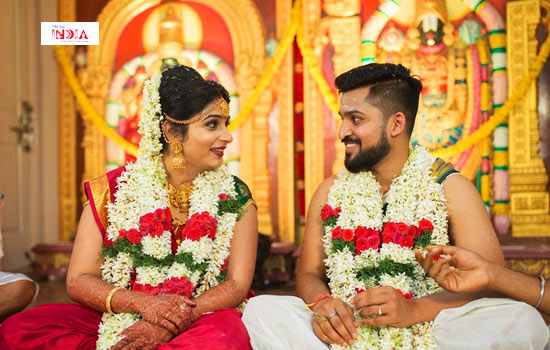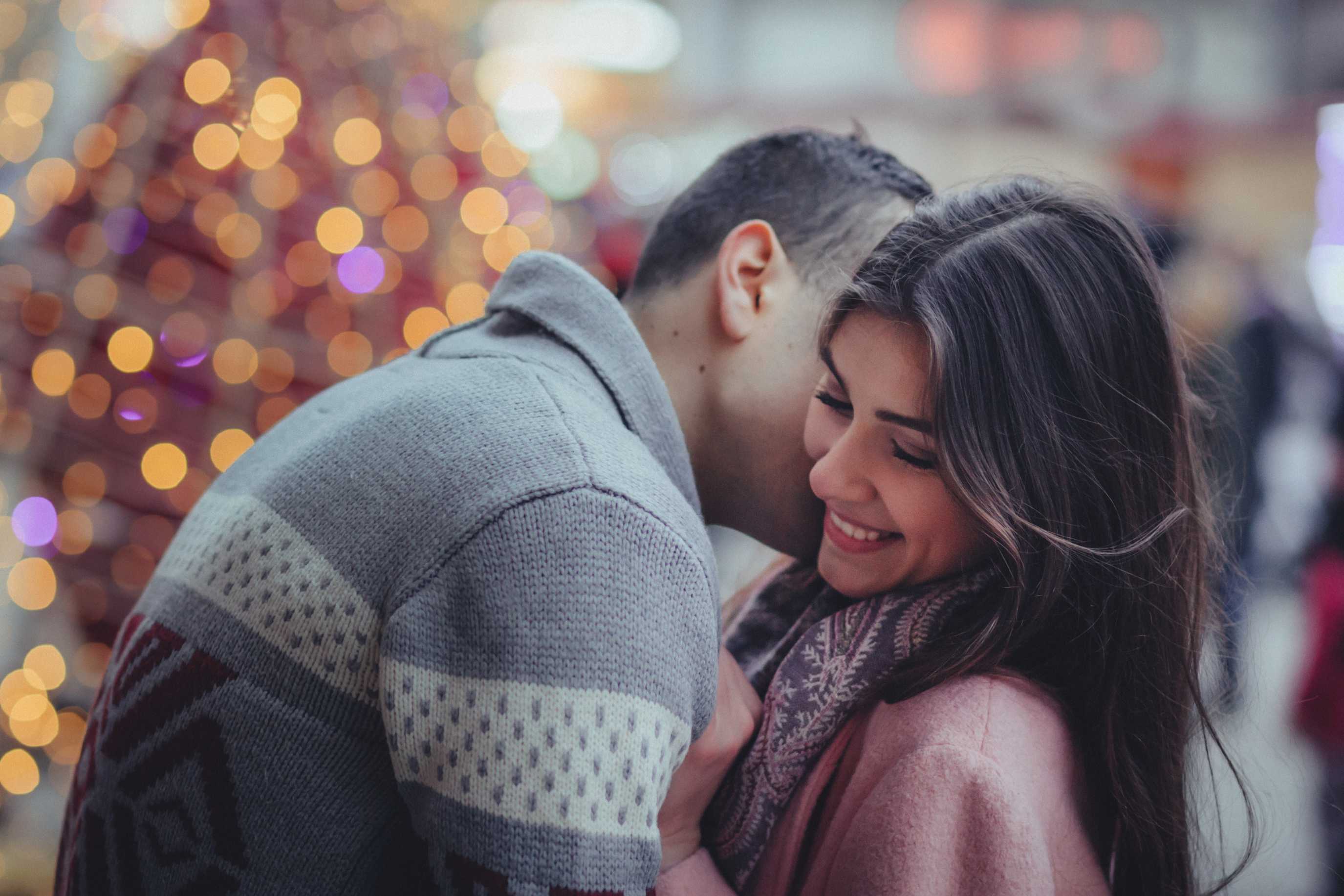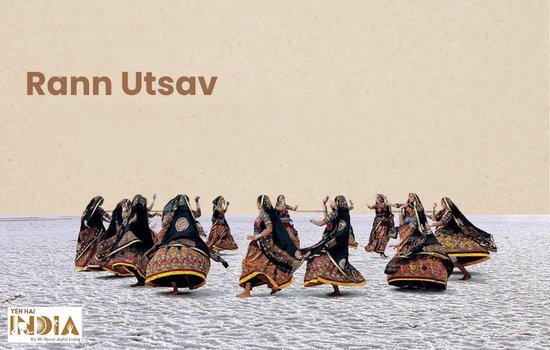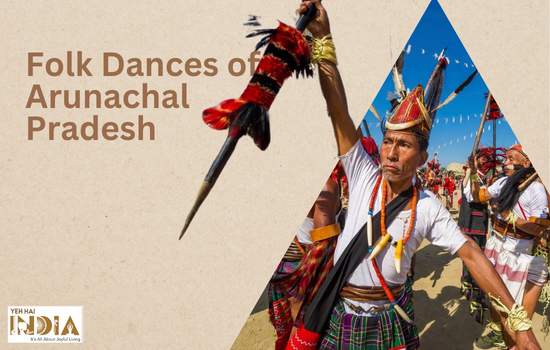Weddings are a beautiful celebration of love. Marriages in the Southern part of India are a bit different from the Northern part. People over there prefer peace rather than being out loud about their wedding.
They celebrate things as per old traditions and customs. It’s a lot more fun to watch them enjoying their festivities. So, let’s have a glimpse at the Tamil Wedding Rituals.
Pre-Wedding Ceremonies
1) NakshatraPorutham:
Coordinating of the horoscope is given the most extreme significance in a Tamil wedding. Horoscopes or nakshatras are coordinated after Vedic rules dependent on twelve focuses or Poruthams like Nadi, Yoni, Rasi, Gana, and so on.
The coordinating of horoscope decides a ton of components for the approaching wedding like the wedding date, exact second for the wedding or muhurtha and different customs also.
2) Marriage Agreement:
The marriage understanding is drafted next by the clerics on the two sides once the marriage is fixed. A gathering is orchestrated at the groom’s house where the different sides trade the marriage arrangements by putting it on a platter containing a lot of bananas, betel nuts, betel leaves and a coconut. Endowments are additionally exchanged between the families.
Recommended Story – Maharashtrian Wedding Rituals
3) Panda Kaal Muhurtham:
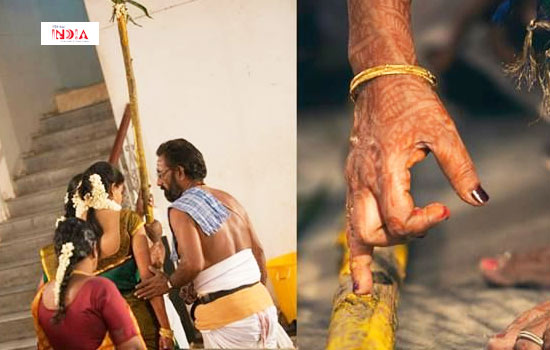
This custom is seen by the lady of the hour’s and the groom’s sides together. The two families visit a sanctuary or may sort out a unique puja at one of the homes, and go to Lord Almighty so the wedding may occur with no obstructions. This is by and large done on the day preceding the wedding.
4) Sumangali Prarthanai:

This is an exceptional puja coordinated towards the Sumangalis or wedded ladies who participate during different ceremonies of the wedding. For the most part these ladies are close family members and family companions.
The ladies, by and large assembled in odd numbers like three or five or seven, gets decked up in conventional nine-yard Madisar sarees. After the fruition of the puja, the lady looks for favors from each Sumangali and gives her some unique blessing like a saree or adornments. They are likewise treated with unique lunches.
5) Pallikal Thellichal:
In this, earthenware pots are enlivened with vermillion and sandalwood glue by five or seven wedded ladies of the family or both the lady of the hour and the lucky man’s families.
Inside each pot, nine distinct sorts of grains or navadhaanyam are put alongside a touch of curd. A Kolam or customary south Indian sand craftsmanship plan that is accepted to be the bearer of best of luck is set up at a unique spot inside the house.
6) Vrutham:
This ceremonial happens at the man of the hour’s put on the early mornings of the day before the wedding. The day connotes progress of the man of the hour from the Bachelorhood or Brahmacharya period of life to Domestic or Garhasthaya stage.
He looks for authorization from his guru, for the most part, his dad to continue to this stage. A sacrosanct string shaded yellow with turmeric is tied around the lucky man’s wrists. In a comparable service or puja, a yellow thread is likewise tied around the lady’s wrists. This string is said to shield the lady of the hour and the lucky man from fiendish energy.
7) Naandi Shraddham:

The groom’s family shows up at the lady of the hour’s place or the setting of the wedding on the morning of the day preceding. The bride’s family invites them with plate brimming with favors like desserts, betel nuts, betel leaves and natural products.
The man of the hour is particularly welcome with a shower of rose water. A festoon is put around the groom’s neck and a spot of sandalwood and vermillion paste is applied on his temple. The lady and his relatives are taken care of desserts arranged by the bride’s mom.
After the greeting is done, ten Brahmins are welcomed over who partake in a custom that offers submission to the families’ withdrawn progenitors. The Brahmins are blessed to receive customary Tamil vegetarian lunch and are given conventional two-piece articles of clothing (veshtiangavastram) alongside betel nuts, betel leaves, coconut, leafy foods. The Brahmins give their blessings to the couple and wish them a prosperous life ahead.
8) Nishchayathram:
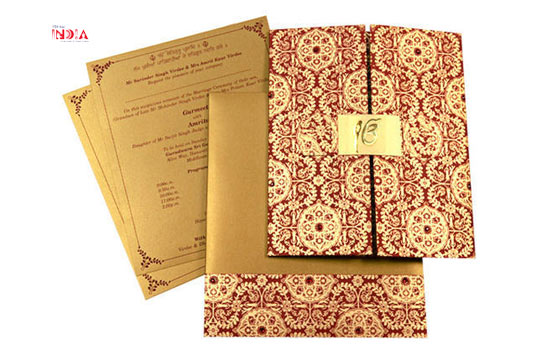
This is the proper engagement ceremony in a Tamil wedding. The ceremonial starts with a puja to Lord Ganesh at the lady’s home. The groom’s family shows up at the bride’s home. They blessing a delightful saree to the situated lady of the hour and furthermore some gems.
They at that point apply a spot of sandalwood paste and vermillion on the lady’s forehead. The sumangalis from the two sides come and top off the free finish of the lady of the hour’s saree with rice, natural products, flowers, coconut, turmeric, betel leaves, and betel nuts.
An arti of the lady of the hour is performed while a beautiful flower garland is tied around her midriff. The lady’s family likewise plays out a comparable custom and blessing new garments to the groom. The lady and the lucky man at that point change into these new garments. Then the couple exchange rings and gets engaged to each other.
9) Lagna Pathirikai:

The custom includes declaration of the wedding and offering verbal greeting to the wedding. The family priests in the wake of counseling two or three’s horoscopes concoct the most propitious snapshot of completing the wedding which they officially draft in the lagnapatrikai.
The lagnapatrikai should obviously plot the names of the relatives, the lady of the hour and the groom’s, the marriage date, and the exact marriage time. This season of the wedding or the Lagna is announced before all the relatives of both the groom’s and bride’s side. The lagnapatrikai is analyzed and endorsed by the tops of the two families.
The pre-wedding rituals of the Tamil Weddings are many, isn’t it? But now it’s time for the main event, i.e. Wedding.
Wedding Rituals
1) Mangalasnanam:
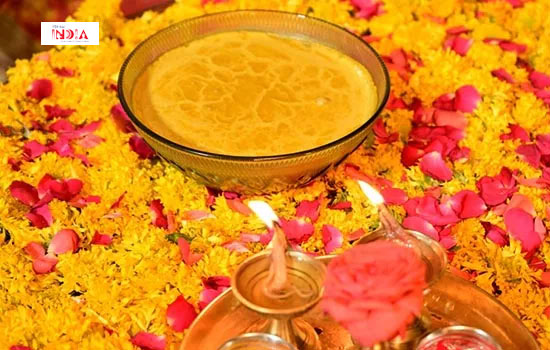
The big day starts at the break of day. The Mangalasnanam custom is observed independently by the groom and bride’s sides. A paste of sandalwood, turmeric, and kumkum is set up by the Sumangalis or wedded ladies. T
They apply oil to the groom/bride’s hair in alternate turns and rub the paste all over their hands and feet. After the custom, the lady of the hour/groom takes a bath down in blessed water to purify their body and soul. They at that point continue to prepare for the wedding ceremony.
2) Gauri Puja:
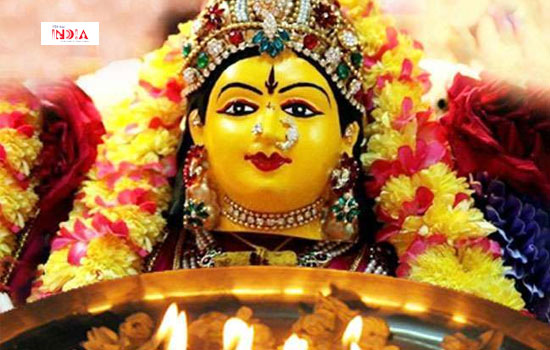
This is a custom that is performed by the bride. A symbol of the Goddess Gauri, who addresses immaculateness, starkness and righteousness, is put on a plate containing rice and kumkum. After the lady has been spruced up, she offers her prayers and plays out a short puja to the Gauri symbol wanting for a joyfully hitched life ahead.
3) Kashi Yathra:
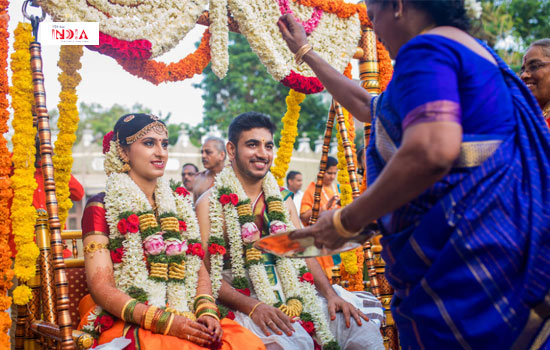
The lucky man’s party show up at the wedding scene and the man of the hour gets and umbrella, strolling sticks and some food things to head out to Varanasi or Kashi, repudiating all common connections to seek after strict investigations.
The bride’s dad at that point blocks him outside the wedding lobby and makes him see the ethics of the homegrown life rather than a loner one. The dad of the lady of the hour at that point guarantees the lucky man to give his little girl to him in marriage.
The groom acknowledges this proposition and gets back to the wedding scene to get hitched. The umbrella is to be kept with the husband to be all through the wedding to help him to remember the choice and his obligations accordingly.
4) Pada Puja:
After the groom shows up at the wedding mandap, the bride’s parents wash his feet with blessed water, milk, sandalwood, and kumkum. His feet are then cleaned dry with colorful flower petals.
5) MaalaiMaatral:
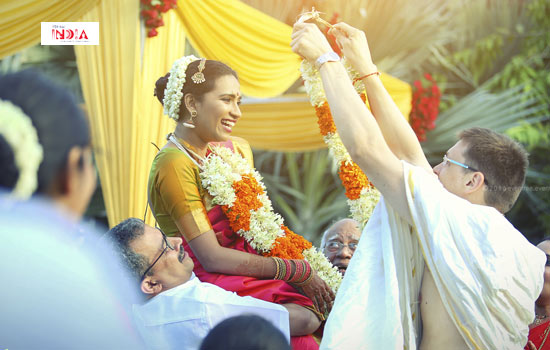
The lady of the hour is then brought into the wedding mandap and the couple exchanges beautiful flower garlands as an initial step of the wedding. The custom is rehashed multiple times in the midst of much perkiness where the groom/bride attempts to sidestep garlanding by the other.
6) Oonjal:

Oonjal alludes to a swing. During this function, the couple is made to sit on a swing which is shaken delicately. The ladies of the family encompass the swing and sing Oonjal Pattu melodies.
The older folks of the family come individually and feed the couple milk and banana and favor them. Ladies from both families convey hued rice balls around the couple situated in the swing in both clockwise and anticlockwise ways multiple times prior to tossing the balls in four cardinal ways to avoid insidious energy.
Older women circumvent the couple holding an earthen light and pot occupied with water multiple times clockwise way. The gentle rocking movement of the swing addresses the violent circumstance that life may present to them.
Recommended Story – Marwari Wedding Rituals
7) Kanyadanam:
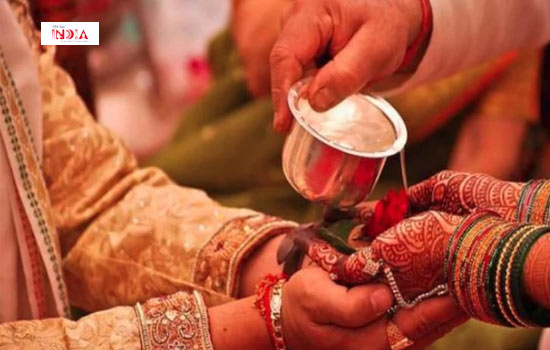
The groom and bride is then approached to venture off the swing. The finish of the lady of the hour’s saree is attached to the furthest limit of lucky man’s angavastram. The lady’s mom at that point applies kajal on the man of the hour’s eyes and the lady’s dad washes his feet.
Through this custom, the lucky man is seen as illustrative of Lord Vishnu. The man of the hour is then situated on the floor at his assigned spot. The dad of the lady of the hour sits confronting the lucky man. The lady is situated on her dad’s lap and a coconut is put on her hands.
The bride’s dad at that point bolsters his little girl’s hands and offers the coconut to the husband to be together. The mother of the lady pours blessed water over the coconut. Consequently, through this proper service, the lady of the hour’s folks offer her to the lucky man and demands him to deal with their little girl for the remainder of their life. The groom’s and bride’s hand is tied with a holy thread to seal their association.
8) Muhurtham:
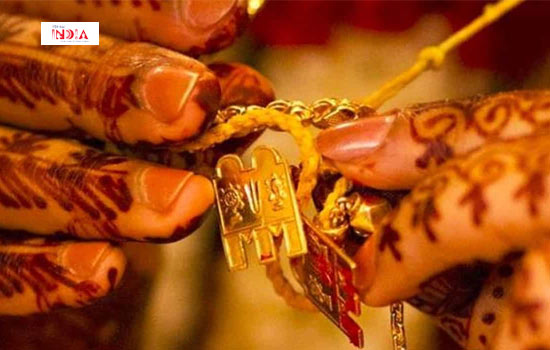
After the culmination of the Kanyadanam custom, the groom’s parents give the lady a nine-yard silk saree representing their acknowledgment of the lady of the hour into their family.
The saree is hung around the lady of the hour’s shoulders while the groom applies vermillion to her hair separating. The lady of the hour at that point goes to change into the saree skilled to her by her parents-in-law. At the point when she gets back to the mandapam, a grass ring is set on her head, over which the burden of a furrow is put and a belt made of reed grass is put around her abdomen.
Water is poured over the burden. This custom is an emblematic token of the way that the lady and the man of the hour together need to defeat the difficulties of life. The Thaali is honored by the cleric and the husband to be ties the Thaali, or south Indian likeness a mangalsutra, around the lady’s neck.
The initial two bunches of the Thaali is placed in by the man of the hour while the third and the last one is placed in by the groom’s sister.
9) Saptapadi:
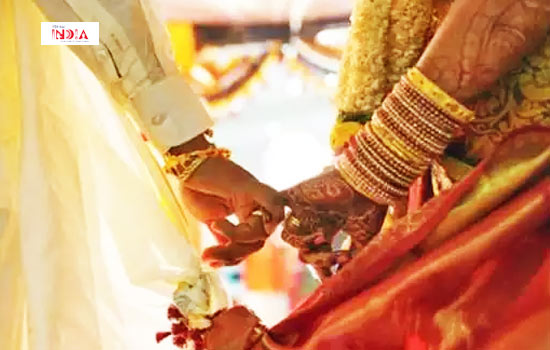
The groom and bride holds each other’s hands and take circles around the holy fire multiple times. Vedic mantras are recited by the pries which plots the seven holy promises of a marriage.
This ceremonial denotes a new start of the couple’s excursion as husband and wife.. Next, the lucky man holds the lady of the hour’s left toe as she ventures over a grindstone. This emblematically addresses the strength of their association.
Post-Wedding Rituals
1) Reception:

The wedding is trailed by a proper gathering at night where the visitors are treated to a lavish vegetarian spread. The love birds are situated on thronelike seats on top of a phase where they can meet and welcome all the visitors.
2) Sammandhi Maryathai:
The two families at that point exchange endowments and the lady plans to leave her fatherly home. She is bid an emotional farewell by her family and friends.
3) Paaladaanam:
Prior to leaving, the groom and the bride lie face down and look for the blessings of the elderly folks. The groom then accompanies the lady to his home.
4) Grihapravesham:
At the point when the bride arrives at the groom’s house, she is given a warm and celebratory welcome. The relative plays out a little arti and escorts her inside the house where she is directed to look for the blessings of the family god first.
5) Valeyadal:
This custom alludes to the conventional acquaintance of the bride with the individuals from the groom’s family who offer her gifts and blessings. A few of the post-wedding games are played to break the ice between the groom and the bride.
6) Maruvidu Varudal:
Three days after the wedding, the couple visits the bride’s home. They are invited with much excitement and feed a delightful lunch. The bride’s parents give two or three presents of garments just as adornments. With this ritual, all the Tamil Wedding rituals come to an end.
Well, Tamil Weddings are simple but quite long. Maybe that’s the unique element of their weddings. So, make sure you attend one to have a refreshing and completely different experience.
Also Read – Sikh Wedding Rituals


